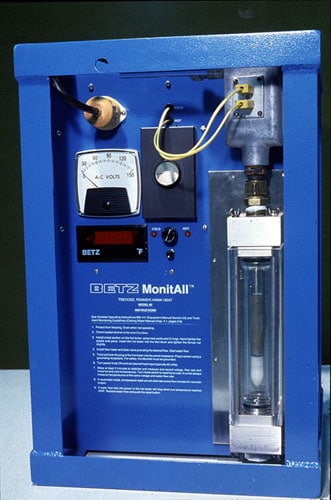Monitoring and Control of Your Water Treatment System – Part 4
Monitoring and Control of Your Water Treatment System - Part 4
Fouling
The below image is of the Betz MonitAll. It is a portable assembly used primarily to measure the fouling and corrosion potential of cooling water streams on heated tube surfaces.
The MonitAll contains a clear flow-through assembly. Sample water flows in at the bottom and out of the top of a tube. A heat probe is inserted into the flow assembly along the axis of the tube. The heat probe generates an adjustable heat flux across a tubular metal test section. Fouling or corrosion can be accelerated if the heat flux is raised above design levels.
There are other specialty systems that are designed to monitor the rate of fouling and corrosion in industrial equipment.
The Betz Model Condenser is a test device used primarily to stimulate surface condenser fouling and corrosion. It consists of a horizontal, cylindrical stainless steel shell with one, two, or four removable tubes. Temperature sensors are located in the shell and tube discharges to monitor temperature difference.
A test heat exchanger is used to to monitor the fouling and corrosion tendencies of a particular cooling water stream. Cooling water passes through two remov-able tubes contained in a cylindrical shell. The tubes, which are available in many different materials, can be arranged for two single-pass or one two-pass operation. Steam or hot condensate flows into the shell and heats the water flowing through the tubes. The condensate exits the shell through a flow meter that is used to monitor heat input.
Sodium
Sodium instrumentation has become very important as a means of determining steam purity. To determine the total dissolved solids concentration of the steam, the sodium level in a cooled steam sample is compared to the ratio of total solids to sodium in the boiler water.
The most common technique used to measure sodium is the specific ion electrode. The sodium specific ion electrode responds logarithmically to changes in sodium concentration. The only other factors affecting the readings are temperature and pH. Temperature is measured by an internal thermistor. A reference electrode provides the primary potential signal required for the measurement. Before the sample contacts the electrodes, the sample is circulated through a diffusion tube that is immersed in ammonia; this procedure eliminates hydrogen ion interference.
For calibration of the specific ion analyzer, both electrodes are immersed in a known standard solution. The electrodes are also immersed in another standard with a tenfold higher concentration of sodium ions for determination of the electrode slope. Modern microprocessor technology has provided advanced calibration techniques that verify electrode stability during calibration.

Dissolved Oxygen Instrumentation
The ability to measure dissolved oxygen is very important, especially in boiler systems, where oxygen corrosion can be very damaging.
A typical dissolved oxygen measuring instrument consists of a sensor, a sensor cell, and an analyzer, as shown to the right. The sensor measures the dissolved oxygen concentration and transmits a signal, proportional to the oxygen concentration, to the analyzer. The analyzer provides a readout in parts per billion or parts per million and an output that can be connected to a recorder or data logging device.
Dissolved oxygen is commonly measured by a membrane-isolated electrochemical cell. This cell contains a cathode, an anode, and an electrolyte solution. A gas-permeable membrane admits the dissolved oxygen from the sample to the electrodes. There, an electrochemical reaction generates an electric current with a magnitude proportional to the dissolved oxygen concentration.



